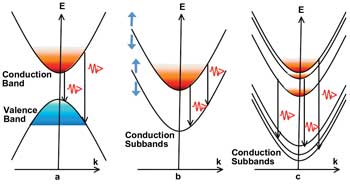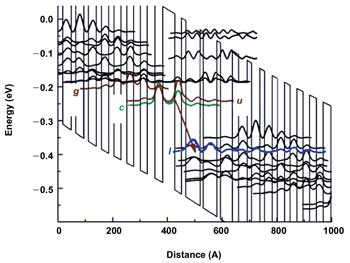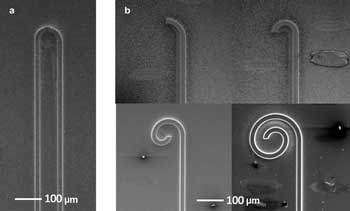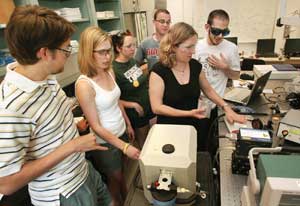Jonathan Hu, Princeton University and Baylor University; and Claire Gmachl, Princeton University
Voltage-tunable output wavelength, broad gain spectra, high output power and efficiency, and innovative cavity geometries give quantum cascade laser-based sensor systems an edge in applications from gas analysis to chemical sensing.
Most vapor molecules have a unique absorption spectrum in the mid-IR region, so this range is of particular interest for trace gas analysis and chemical sensing.
And quantum cascade (QC) lasers are ideal candidate light sources for mid-IR spectroscopy: Their emission wavelength reaches from the mid- to the far-IR with good power efficiency.1,2 QC lasers are based on the intersubband transitions between quantized subbands in multiple-quantum-well heterostructures, a design that is fundamentally different from that of conventional semiconductor lasers using interband transitions across a bandgap.3
Because QC lasers use intersubband optical transitions, they were once thought to be inefficient, and their emission spectra were thought to be inherently limited in tunability and breadth. However, research in recent years has shown that different quantum designs can be implemented to significantly improve the performance of these lasers.2,4 Figure 1a demonstrates how, in the conventional semiconductor laser, electrons transition between conduction band and valence band. Photon emission results from the recombination of carriers across the bandgap.

Figure 1. Schematic diagram for (a) emission from conventional semiconductors, (b) emission from voltage-tunable subbands, and (c) broad emission from multiple subbands. Images courtesy of MIRTHE.
In QC lasers, transitions take place between subbands in one band, usually the conduction band, in multiple-quantum-well heterostructures (Figure 1b). Applying different voltages can achieve voltage-tunable emission wavelength via a Stark effect.5,6 The detailed design that achieves this includes a coupling state, which is inserted between the injector ground state and the upper laser state.7 Alternatively, Figure 1c shows the transitions from the multiple subbands to yield a broadband spectrum. In recent years, with better performance, QC lasers have been successfully applied to trace gas analysis and spectroscopic sensors.1
Voltage-tunable output
Many sensor applications require a sufficient wavelength-tuning range. Common techniques for tuning QC lasers include temperature adjustment, which yields a small tuning range, and mechanical tuning via an external cavity. Simply changing the voltage applied on a QC laser, while most convenient, generally produces a very small tuning range above the lasing threshold. The reason is that, above the lasing threshold, the voltage over the active region does not increase as fast as the applied external voltage because electrons transit across the active region faster and faster via stimulated emission with the stronger light intensity.
To overcome this barrier, a two-step coupling design was applied to provide a wide-wavelength tuning range for lasers above the lasing threshold.7 Figure 2 shows the conduction band diagram for this design. A coupling state c is inserted between the injector ground state g and the upper laser state u.7 This two-step coupling feature leads to a larger dynamic voltage range over the active region above threshold. With this setup, QC lasers can be tuned over 100 cm—1 (8.3 to 9 µm) above threshold at a constant heat sink temperature of T = 295 K, which is about a threefold increase compared with earlier designs.7

Figure 2. Conduction band diagram of a portion of the active regions and injectors and the moduli squared of the relevant wave functions of the two-step coupling design.7
Broad gain spectra
QC lasers with broad gain spectra are ideal candidates for multianalyte mid-IR spectroscopy and sensor applications for broadband absorbers. The bound-to-continuum QC laser design has more than one lower laser state,8 and multiple transitions from the upper to the lower laser states contribute to a broad gain spectrum. Novel QC laser designs termed “continuum to bound” have two lower injector states strongly coupled with the upper laser state, forming an upper-level continuum.9
QC laser structures with continuum-to-bound broadband gain resulted in gain spectral widths of about 22 percent of the laser peak emission energy, i.e., 250 cm—1 in the 7- to 9-µm (around 1150 cm—1) wavelength region.9 Alternatively, transitions can be designed with multiple upper and lower laser states. This approach is called “continuum to continuum.” This design resulted in gain spectral widths of about 20 percent of the laser peak emission energy, i.e., 430 cm—1 in the 4- to 5-µm (around 2100 cm—1) wavelength region.10 Heterogeneous cascade QC laser design also showed the broad gain spectral width of 25 percent of center frequency and proved to be used in an external-cavity QC laser for tunable wavelength output.11,12
Innovative geometries
Greenhouse-gas monitoring and breath analysis for medical diagnostics often require single-mode operation of the light source. Single-mode emission of QC lasers is usually achieved via either a distributed feedback grating or an external cavity. However, those approaches require complicated device fabrication and coating processes, or an external mirror system with high-precision alignment.
Figure 3a shows a scanning electron microscope image of the coupled Fabry-Perot cavity, which consists of two parallel straight sections of equal length and a half-ring section. The entire cavity looks like a hairpin, with the straight section much longer than the half-ring section. Although the two straight sections and half-ring section have no physical boundaries in between, they can be seen as individual cavities and together form a monolithic coupled cavity, which enhances the mode selectivity.13 Tunable single-mode mission with a side mode suppression ratio of 27 dB can be achieved.13 The structure can be further simplified to a candy-cane shaped Fabry-Perot cavity design consisting of a straight ridge waveguide and a spiral structure at one end.

Figure 3. (a) Scanning electron microscope image of a coupled Fabry-Perot cavity, consisting of two parallel straight sections of equal length and a half-ring section. (b) Simplified candy-cane-shaped Fabry-Perot cavity design, consisting of a straight ridge waveguide and a spiral structure at one end. The four types of spiral structures explored have turns of 90°, 180°, 360° and 540°.13,14
Four types of spiral structures with turns of 90°, 180°, 360° and 540° have been explored (Figure 3b). Single-mode operation with >60 percent yield is achieved at 80 K with a side mode suppression ratio of 25 dB.14
Efficient output power
A crucial factor in QC laser performance is power efficiency, defined as the ratio of total output light power to input electric power. Analysis shows that a fast tunneling rate is important to achieve a high laser wall-plug efficiency.15 One way to increase the tunneling rate is to increase the coupling strength between the injector ground level and the upper laser level.
The experimental implementation of such a design strategy uses a much thinner injection barrier between the injector and active regions.16 The ultrastrong coupling arrangement enables the experimental realization of QC lasers with 40 to 50 percent wall-plug efficiency when operated in pulsed mode with temperatures of 160 K or lower.16 QC lasers using a single-well injector design also showed high wall-plug efficiency of 53 percent at 40 K.2
QC laser-based sensor systems
Quartz-enhanced photoacoustic spectroscopy (QEPAS) detects acoustic pressure waves using a resonant transducer in the form of a quartz tuning fork. QEPAS has detected various chemical species, such as NH3, H2O, CO2, N2O, CO and CH2O.17 A continuous-wave, thermoelectrically cooled external-cavity QC laser can be used as a light source for this type of spectroscopy, which has many unique properties, including an extremely high quality factor of more than 10,000 rapid spectral measurements, immunity to environmental acoustic noise, high sensitivity and a wide dynamic range.18,19 And the small size of the QEPAS module allows compact integration with QC laser sources.
Faraday rotation spectroscopy exploits magnetic circular birefringence observed in the vicinity of Zeeman split absorption lines and provides enhanced detection of paramagnetic molecules.20 The magnetic field along the direction of optical beam propagation induces the circular birefringence, which leads to rotation of the polarization axis of linearly polarized light. Using broadly tunable external-cavity QC lasers allows selection of the optimum line for the Faraday rotation spectroscopy detection of nitrogen oxide and provides flexibility in selecting the required laser wavelength to perform sensitive detection of paramagnetic species.21
The QC laser open-path system (QCLOPS) was designed to detect a range of trace gases for field deployment. The system, which potentially can monitor ozone, ammonia and carbon dioxide, was successfully deployed in Beijing during the 2008 Olympic Games to capture changes in ozone levels.22 The QCLOPS was also tested in sensing complex chemicals with wood smoke in the rural fishing village of Elmina, Ghana, in 2010.23 Two gases from the wood smoke, 2-methyl phenol and benzyl alcohol, were targeted.23
Meet the authors
Jonathan Hu was a research associate in the department of electrical engineering at Princeton University in New Jersey. He is now an assistant professor in the department of electrical and computer engineering at Baylor University in Waco, Texas; email: jonathan_hu@baylor.edu. Claire Gmachl is a professor in the department of electrical engineering at Princeton University; email: cgmachl@princeton.edu.
The authors acknowledge the support of NSF-ERC (Grant No. EEC-0540832) and DARPA-EMIL.
References
1. R.F. Curl et al (2010). Quantum cascade lasers in chemical physics. Chem Phys Lett, Vol. 487, pp. 1-18.
2. Y. Bai et al (2010). Quantum cascade lasers that emit more light than heat. Nature Photonics, Vol. 4, pp. 99-102.
3. J. Faist et al (1994). Quantum cascade laser. Science, Vol. 164, pp. 553-556.
4. A. Lyakha et al (2010). High-performance continuous-wave room temperature 4.0-µm quantum cascade lasers with single-facet optical emission exceeding 2 W. Proc Natl Acad Sci USA, Vol. 107, pp. 18799-18802.
5. S. Suchalkin et al (2007). Wavelength tuning of interband cascade lasers based on the Stark effect. Future Trends in Microelectronics: The Nano Millennium. S. Luryi, J. Xu, A. Zaslavsky, eds. Chapter 33.
6. S. Suchalkin et al (2007). High-speed Stark wavelength tuning of midIR interband cascade lasers. IEEE Photon Technol Lett, Vol. 19, pp. 360-362.
7. Y. Yao et al (2009). A widely voltagetunable quantum cascade laser based on two-step coupling. Appl Phys Lett, Vol. 95, 021105.
8. J. Faist et al (2001). Quantum-cascade lasers based on a bound-to-continuum transition. Appl Phys Lett, Vol. 78, pp. 147.
9. Y. Yao et al (2010). Broadband quantum cascade laser gain medium based on a “continuum-to-bound” active region design. Appl Phys Lett, Vol. 96, 211106.
10. Y. Yao et al (2010). High performance continuum-to-continuum quantum cascade lasers with a broad gain bandwidth of over 400 cm—1. Appl Phys Lett, Vol. 97, 081115.
11. A. Wittmann et al (2008). Heterogeneous high-performance quantum-cascade laser sources for broad-band tuning. IEEE J Quantum Electron, Vol. 44, pp. 1083-1088.
12. A. Hugi et al (2010). External cavity quantum cascade laser. Semicond Sci Technol, Vol. 25, 083001.
13. P.Q. Liu et al (2011). Single-mode quantum cascade lasers based on a folded Fabry-Perot cavity. Appl Phys Lett, Vol. 98, 061110.
14. P.Q. Liu et al (2011). Single-mode quantum cascade lasers employing a candy-cane shaped Fabry-Perot cavity. CLEO, paper CMI3.
15. J. Faist (2007). Wallplug efficiency of quantum cascade lasers: critical parameters and fundamental limits. Appl Phys Lett, Vol. 90, 253512.
16. P.Q. Liu et al (2010). Highly power-efficient quantum cascade lasers. Nature Photonics, Vol. 4, pp. 95-98.
17. A.A. Kosterev et al (2005). Applications of quartz tuning forks in spectroscopic gas sensing. Rev Sci Instrum, Vol. 76, 043105.
18. V. Spagnolo et al (2010). NO trace gas sensor based on quartz-enhanced photoacoustic spectroscopy and external cavity quantum cascade laser. Appl Phys B, Vol. 100, pp. 125-130.
19. A.A. Kosterev et al (2010). QEPAS for chemical analysis of multi-component gas mixtures. Appl Phys B, Vol. 101, pp. 649-659.
20. S.G. So et al (2011). VCSEL based Faraday rotation spectroscopy with a modulated and static magnetic field for trace molecular oxygen detection. Appl Phys B, Vol. 102, pp. 279-291.
21. R. Lewicki et al (2009). Ultrasensitive detection of nitric oxide at 5.33 micron by using external cavity quantum cascade laser-based Faraday rotation spectroscopy. Proc Natl Acad Sci, Vol. 106, pp. 12587-12592.
22. A.P.M. Michel et al (2010). Quantum cascade laser open-path system for remote sensing of trace gases in Beijing, China. Opt Eng, Vol. 49, 111125.
23. E.N. Bentil et al (2011). Deployment of a quantum cascade laser open-path gas sensor for water vapor and wood smoke analysis. CLEO, paper JMC6.
About MIRTHE

Students and postdocs at work in the MIRTHE lab at Princeton University.
The NSF Engineering Research Center on Mid-InfraRed Technologies for Health and the Environment (MIRTHE) develops quantum cascade laser-based mid-IR chemical sensors for environmental monitoring, homeland security and medical diagnostics through close collaboration with a group of industrial companies. For a list of collaborators, visit www.mirthecenter.org/industry/current_members.aspx. MIRTHE also is actively involved in educational outreach activities such as Research Experience for Undergraduates and K-12 programs.